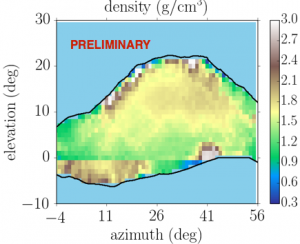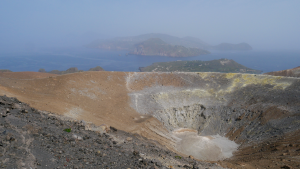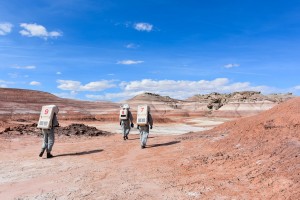
Researchers can “X-ray” volcanos to find out more about their inner structure. This is a radiography of the extinct Puy de Dome in France. Image: TOMUVOL collaboration, 2018
Technology developed under the AIDA-2020 project is sure to make the most out of collisions at future colliders. But did you know it might also be able to save lives? One detector made of RPCs – resistive plate chambers – improved under AIDA-2020 is set to take up residence at the side of a volcano in autumn to measure its inner structure using cosmic muons. The technology is called muography.
Muography as such is not a new technology. It uses cosmic muons – particles generated in the Earth’s atmosphere when cosmic rays enter it – to “X-ray” large objects that you can’t study any other way without destroying them. Scientists record the number of muons that enter a detector after having passed through this object to analyse the density distribution and thus look for internal structures or gaps. The very first object to be studied that way in the 1970s was a pyramid. A few more pyramids have been “muographed” since to look for hidden chambers. And it’s not only archaeology that can benefit from this technology but also other sciences, for example geology: another large area of study are volcanoes.
A new French-funded project will make the first multi-disciplinary all-round study of a volcano, including a muon detector based on technology developed under CALICE (CAlorimeters for LInear Collider Experiments) that will record its inner structure. The location is on one of the Aeolian Islands off Sicily in Italy called Vulcano. Topographical, geological, satellite and seismic data will be combined with information about gravity, temperature, gas mixture and of course muography to create a case study that will probably some day be applied to understand and predict the behaviour of all similar volcanos.

This vulcano will be the object of the first multi-disciplinary study, also including muography. Image: Cristina Carloganu
The leader of the muography part of this exhibition is Cristina Carloganu from the IN2P3-Laboratoire de Physique LPC in Clermont-Ferrand, France. Carloganu did her PhD at the ANTARES neutrino detector (which studies muons caused by neutrinos), has worked on the LHCb experiment at CERN and helped develop the different calorimeter types for CALICE under AIDA. When she heard about muographic studies of volcanoes in Japan and the technology used for them, she thought that the RPCs she had been working on could probably improve the resolution of future studies of this kind.
Re-using gas RPC chambers built in Lyon for CALICE and building new ones she “X-rayed” her first (extinct) volcano, the Puy-de-Dome in central France, as part of the “TOMUVOL” experiment. “It was the first muographic study of a volcano thicker than a kilometer,” she recounts.
The new project is taking volcano muography to a new level. First of all Vulcano is an active, hydrothermal system. “That means that there is lots of movements of fluids inside the mountain,” Carloganu explains. “The status of the volcano depends on the path of these fluids and how it opens and closes. Our detector will help make this visible.” Secondly, the detector is out in the wild, without gas or electricity supply and potentially exposed to storms, lightning and cable-hungry animals.
The solution to these problems, housing a self-sustained detector in a container, might eventually feed back into how detectors in high-energy physics are built and run. One of the improvements that is coming out of this study of Vulcano is a much lower gas consumption and gas tightness of the RPCs, which is an important factor for LHC experiments as well.

RPC technology was also used for a Mars study (where the Utah desert plays Mars). Image: UCL to Mars
The same practical problems are being addressed by Andrea Giammanco from the Centre for Cosmology, Particle Physics and Phenomenology in Louvain-la-Neuve, Belgium. He is working on a small-area rather than a large-area detector . He and his team have developed a prototype of a portable, battery-driven small-area detector with very high resolution and very low power consumption and no gas leakage to also study archaeological or geological phenomena “in the wild.” The prototype has even taken part in a Mars study project in the Utah desert. The whole detector is based on RPC studies for the CMS experiment at the LHC and might soon go into serial production with a bit of luck and funding from industry.

Recent Comments